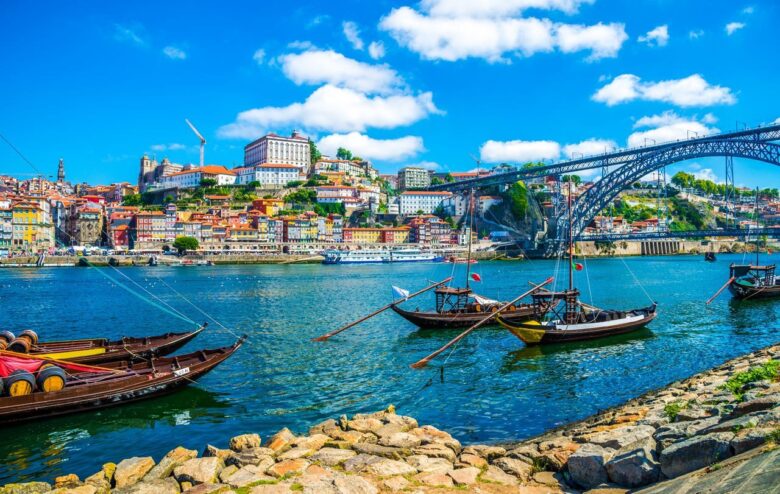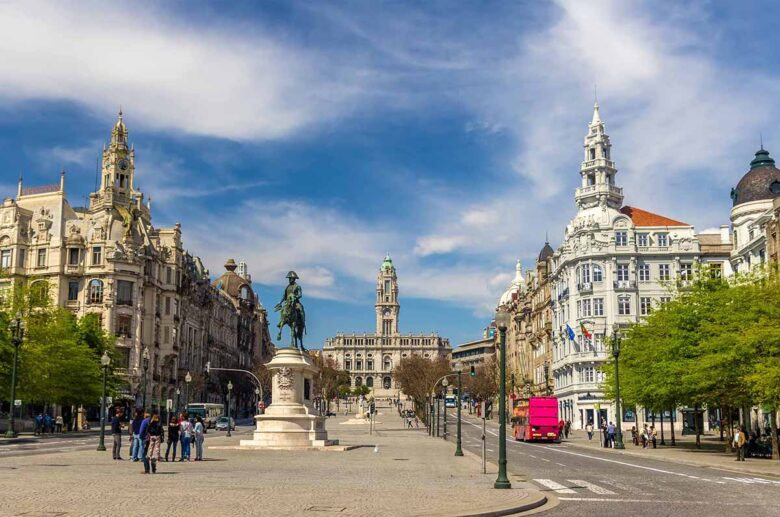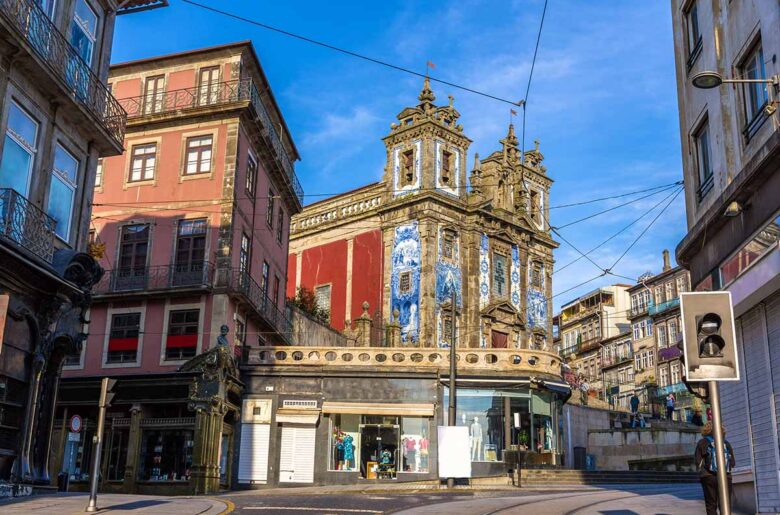
Wondering where to stay in Porto? In this blog we have picked seven of the best areas to stay in Porto, to help you make the most of your time in this stunning old city.
The city of Porto is the new destination of choice in Portugal, for those short-week breaks and long weekends. Situated along the northwest coast on the Douro river estuary, it is a city full of history and historic buildings, of modern architecture and street art.
A city with Europe’s ‘A’ list of top chefs, displaying their culinary expertise in the hotels and gourmet restaurants. It is a place of coastal walks and beautiful gardens, of fabulous viewpoints, designer label shopping, and a friendly, vibrant nightlife.
Where to stay in Porto: Best areas and hotels
1. Centro-Baixa, best area to stay in Porto

Centro Baixa stretches from the Avenida dos Aliados (Avenue of the Allies) at the one end, to Praça da Liberdade (Liberty Square) at the other. As the centre for Porto’s local administration, the top end of the avenue is dominated by the city’s commanding Municipal Council Building.
Pre-2004, the area was slowly falling into disrepair with businesses closing, buildings crumbling, and residents choosing to move to other areas. In 2004 things began to change, with much of the area being classified as a World Heritage Site.
Historic buildings began to be renovated, and many smaller properties refurbished. New businesses began to open up, especially in the hospitality sector, where new trendy bars and clubs began to draw customers from across the city. Now it is one of the favourite places to stay in Porto.
Buildings of interest include the São Bento Railway Station, with its tiled entrance hall, the Church of Misericordia with its impressive baroque façade, and the Church dos Clérigos, with its magnificent tower, providing some of the most stunning views over the city from 75 metres up.
If you have a love of gold, a stroll down the Street of Flowers (Rua das Flores), will get you to the stores and workshops of the local goldsmiths.
Other visitor attractions include the reintroduced tram network and the Dom Luis I Bridge. Guided tours to various Port Houses and storage facilities are available, as well as river cruises.
Myriad luxury designer outlets, shopping malls, cafes, coffee shops, bars, and restaurants can be found in the maze of tightly packed streets.
For your stay in Porto, Centro-Baixa has an excellent range of accommodations to suit all ages, budgets and needs.
BEST PLACES TO STAY IN CENTRO – BAIXA
- ($$$) Pestana Porto – A Brasileira, City Center & Heritage Building
- ($$) Catalonia Porto
- ($) Legendary Porto Hotel
2. Ribeira, where to stay in Porto for nightlife

Sitting in the centre of the old town, and one of the oldest districts in Porto, Ribeira has been a UNESCO Heritage Site since 1996, and is a favourite attraction with visitors from across the world.
The history of the area dates back to the 14th century, and the ensuing years saw increasing amounts of trade being off-loaded at the Ribeira quayside, for distribution throughout the city.
Now, the wide, picturesque, paved promenade has plenty of outdoor seating, for visitors to rest those tired feet, and take in the relaxing views of the Port Houses on the opposite bank.
At the rear of the promenade, cafes, bars, restaurants, and souvenir shops stretch along the waterfront, while tall multi-storey colourful houses rise up the hill alongside the narrow, winding streets.
The Praça da Ribeira (Ribeira Square) is the hub of this delightful medieval area, as well as the centre for night time activities.
On one side you will see a massive granite wall depicting the Portuguese coat of arms, alongside a statue of John the Baptist. On the other side you can wine and dine in the many excellent bars and restaurants around the square.
If you have a love of sacral architecture, a climb up the steep narrow lanes from the square will get you to the hilltop and the fort-like cathedral.
Although laid down in the 12th century, re-built in the 13th century, and modified in the 18th century, some of the old stonework still survives, along with a 14th century Gothic cloister and rose window inside.
If you don’t want to go right to the top, continue up the steep, windy Rua de São João toward the centre of Porto, and then branch off to the right, looking out for the Rua da Fonte Taurina, and the Rua da Reboleira.
Old cobbled alleys with an atmosphere all their own, they house some of Ribeira’s most popular restaurants.
As you explore the area, look out for the Rua Alfandega (Customs House Lane). Here you will find the Casa do Infante, a 14th century house said to be the birthplace of Prince Henry the Navigator in 1394.
Having previously been the Customs House, and then The Royal Mint, this imposing medieval townhouse now protects the city’s archives, with a museum section displaying many roman artefacts discovered when excavating the site.
If you’re looking for photographic opportunities, the Ponte Dom Luis I bridge dominates the area, carrying the Metro system on the upper level, and road traffic on the lower level. There are pedestrian walkways to both elevations, with some stunning views to be had from the top of the bridge.
For those wanting to stay in Porto; hotels, guest houses, self-catering apartments, and hostels are all plentiful around the area, and all within easy reach of the waterfront and Ribeira Square.
BEST PLACES TO STAY IN RIBEIRA
- ($$$) Pestana Vintage Porto Hotel & World Heritage Site
- ($$) Descobertas Boutique Hotel Porto
- ($) Pimms Home Ribeira
3. Cedofeita, Santo Ildefonso, Sé, Miragaia, São Nicolau and Vitória, very convenient neighborhood

Before 2013, the parishes of Cedofeita, Santo Ildefonso, Sé, Miragaia, São Nicolau and Vitória, were individual areas within Porto, some of them with a land area of less than .5 km².
Strangely, having merged the communities in 2013, instead of renaming the new parish, the council chose to maintain each individual community name in the title.
Now an area of some 5.5 km², Cedofeita… stretches from the centre of Porto to the river, and is considered to be one of the city’s up and coming districts, with popular fashionable shopping areas, bars, restaurants, guest houses, hotels and self-catering apartments.
It is particularly favoured by older families and couples, as a base to explore the city and enjoy the local attractions.
Dotted around the area there are a number of beautiful parks and gardens such as Jardim do Palácio de Cristal and the Rotunda da Boavista. Admire the statues at the Jardim Teófilo Braga, and the water features at the Jardim do Marquês de Pombal.
Throughout the area you will find modern trendy shopping malls alongside traditional stores, markets, and souvenir and antique shops. If you have an interest in the arts head to the Rua Miguel Bombarda and its Art Galleries.
Many of Porto’s major tourist attractions are within a short walk or tram ride, with plenty of cafes and coffee shops offering the chance to stop and take in the local atmosphere.
In the evening local Portuguese restaurants give you the chance to sample traditional cuisine, while international restaurants offer dishes from around the world. You can find large bustling eateries for the whole family, or small romantic bistros for those special occasion evenings.
The nightlife too can be as quiet or busy as you want it, with bars to suit every taste. If you want somewhere to dance or party the night away, look up the Rua da Galeria de Paris, for a selection of lively entertaining bars, and some excellent restaurants.
BEST PLACES TO STAY IN PORTO IN CEDOFEITA
- ($$) Eurostars das Artes
- ($$) Exe Essenzia Porto
- ($) MyStay Porto Centro
4. Miragaia, a place to stay in Porto for a relaxing, laid back weekend

Sitting alongside Ribeira on the River Douro, the two parishes blend seamlessly together as the narrow streets, cobbled alleyways, and tall, narrow terraced houses of Ribeira continue through into Miragaia.
The area dates back to the 14th century, when the original parish was built outside the walls of the city, and was home to Porto’s Armenian and Jewish communities.
As with most of Porto, the area is hilly; and narrow roads and pavements can be quite steep. Although exploring by foot is definitely the way to get the most from your stay in Miragaia, if you feel all that effort is a little too much, the tram system is a great second alternative for your sightseeing trips.
Major attractions in Miragaia include the Church of São Pedro, The English Club, the Alfândega Nova (Customs House, and Transport and Communications Museum), the Palácio das Sereias (Staircase and the Sirens’, Palace), and the Soares dos Reis National Museum, where Porto’s finest artwork is housed in the Carrancas Palace.
Pleasant sunny days can be spent leisurely walking the windy streets and cobbled alleyways of Miragaia, looking for those souvenir and antique shops, cafes, coffee shops, and restaurants that so many miss sticking to the main tourist routes.
Book a river trip, or visit one of the many Port Houses for a tour of how Portuguese Port is produced. If you’d rather stay on the flat, make your way to the quayside and stroll the riverbank from Miragaia to Ribeira.
In the evening the parish comes alive with bars and restaurants catering for every taste. Enjoy an unhurried dinner in one of the many restaurants. Find a tavern on the waterfront with a terrace, and enjoy a beer or glass of wine as the light breeze ripples the reflections on the water.
If you’re looking at Miragaia for your stay in Porto, the area has a good selection of budget and luxury hotels, guest houses, and self-catering accommodation.
BEST PLACES TO STAY IN MIRAGAIA
5. Vila Nova de Gaia, great for wine tasting

Wherever you are in Porto, a meal wouldn’t be complete without a glass or two of Portugal’s world famous port wine with a selection of local cheeses. If you choose to stay in Vila Nova de Gaia, or Gaia as it is locally known, you can go a step further.
Gaia has been the centre for maturing, blending, and bottling port wine since the 17th century. Back in the day, casks of wine from wineries across the Upper Douro Valley were transported by barge down the river to the Port Houses of Gaia right up to 1952. Nowadays they are transported by road.
One of the highlights of your stay in Vila Nova de Gaia should be a tour of at least one of the more than 20 Port Houses offering daily tours to see the process first hand, and taste the finished product.
Gaia sits on the opposite bank of the river to Miragaia and Ribeira, and is actually a city in its own right, pushing back inland from the river. If you are staying in these areas, it is easily reached by ferry or across the Dom Luis bridge, and has much more to enjoy than just the Port Houses.
The circular shape of the 17th century Serra de Pilar Monastery can be seen from across the water. During more turbulent times it was commandeered by Britain’s Duke of Wellington during the Peninsula War of the 1800s.
To get a bird’s eye view above Gaia and across the water, book a ride on the new cable car. Visit the Teixeira Lopes Museum. Born in 1866, Teixeira Lopes was a native of Gaia and his work can be found all around the area. He died in 1942.
Visit Praia de Miramar, and take in the Lord of the Stone baroque chapel. Sitting on a hard rocky outcrop, it has defied the sea for over 350 years.
If you have the kids with you, jump a bus or tram and in 10 minutes you can be visiting the Santo Inácio Zoo with over 300 species on show.
If all that sightseeing is getting too much, chill in one of the beautiful gardens such as the Jardim do Morro, or take time out to enjoy a light lunch on the terrace of one of the many cafes and bars along the way.
To keep you close to the centre of everything during your stay in Porto, Vila Nova de Gaia has an excellent selection of friendly bars and restaurants, international and local hotels, guest houses, self-catering opportunities, and hostels.
BEST PLACES TO STAY IN VILA NOVA DE GAIA
- ($$$) The Yeatman
- ($$) Caléway Hotel
- ($) Park Hotel Porto Gaia
6. Avenida da Boavista, where to stay in Porto for shopping

Running between the Military Hospital and Castelo do Queijo, the Boavista Avenue is, at 5.5 km long, the longest street in Porto. Originally laid down in the mid-1800s and completed in 1917, the avenue begins on the Rue da Boavista, and ends at the seafront at Castelo do Queijo.
Originally a residential area for rich merchants and the nobility, the street slowly became the cultural and economic centre of Porto. Still very much an affluent area of town, Boavista Avenue today caters for everyone.
Now a mix of sumptuous 1850s town houses, many converted for commercial use, modern office blocks, hi-end hotels, restaurants, bars, shopping malls, and entertainment venues stretch the length of this wide avenue.
Luxurious shopping centres offer designer labels such as Dolce & Gabbana, Hugo Boss, and Versace, exclusive jewellery outlets, and footwear stores. With plenty of bars, cafes, and coffee shops dotted along its length, you’re never short of somewhere to stop-off for some light refreshment.
If you’re scoping out restaurants for that evening dinner, look up the Bull and Bear on the avenue, they specialise in marinated sea bass. Or if you prefer red meat, look up the Capa Negra II for traditional Portuguese cuisine.
One of the must visits if you’re staying on the Avenida da Boavista (and even if you’re not), is the Casa da Música (House of Music). A contemporary building inaugurated in 2005, it still causes much discussion amongst the locals, due to its innovative construction.
What can’t be argued about are the fantastic acoustics of this purpose built music venue. In concerts and recitals all forms of music are catered for, from Portuguese fado, to rock, jazz, electronic, and classical music.
During the day the Music House is open for tours, and also has a number of bars and restaurants for your entertainment.
If you’re considering the Avenida da Boavista for your stay in Porto, the whole length of the avenue has an excellent selection of hotels to suit most budgets and requirements.
BEST PLACES TO STAY IN PORTO IN AVENIDA DA BOAVISTA
7. Paranhos, affordable accommodation in Porto

Although predominantly residential, Paranhos houses a number of faculties for the University of Porto. Consequently, much of the private accommodation is let to the many young university students enrolled in the colleges.
The area is also home to Porto’s large Hospital de Säo Joäo. Although the parish has little in the way of visitor attractions other than the Areosa Church, the fact it is just ten minutes from Porto’s centre makes it popular with people wanting to stay in Porto, outside of the city centre.
There are a good number of local shops, a shopping centre, cafes, bars, restaurants, and fast food outlets, especially around the university areas. While using Porto’s excellent public transport infrastructure, you are never far from those sites and attractions you want to visit.
There is a good selection of budget hotels and apartments around Paranhos for those wishing to stay in Porto, away from the middle of town.
The very nature of Porto, its ancient history, narrow streets, tall narrow buildings, and stunning views make it the ideal place to be explored on foot. Wherever you choose to stay in Porto, pick a route, get the walking shoes on, and prepare to be amazed.
BEST PLACES TO STAY IN PORTO IN PARANHOS